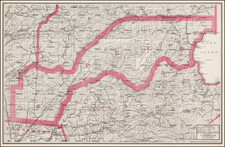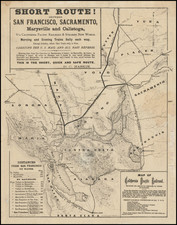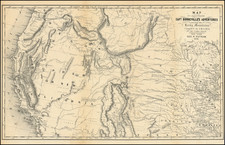La Parte Occidentale Dell'Antico, E Nuovo Messico Con Florida E La Bassa Luigiana Delineata sulle ultime Osservazioni, printed in Rome at the Calcografia Camerale in 1798 by Giovanni Maria Cassini, is a striking example of Cassini's work, detailing California, Arizona, New Mexico, parts of Texas, Baja California, and Mexico. This 18th-century map, possibly the sole instance from that era to feature a decorative cartouche and vignette, offers an intricate view of the region's geography, extending from the Rio Grande to the Colorado River, and the Gila River.
During the late 18th century, the territories depicted on the map were part of New Spain, and the region was a patchwork of evolving frontiers and varied cultures. The Rio Grande is shown extending to the north, reaching as far as Taos and Santa Fe, while the Colorado River and the more or less properly located Gila River are also featured. These waterways served as essential lifelines, carving out the landscape and serving as routes for exploration, trade, and settlement.
Significantly, Cassini's map provides information on various indigenous tribes, including the Yuma, Cocomaricopa, and Apache, along with multiple settlements in Arizona and New Mexico. Prominent locations such as San Diego, Santa Catarina, San Petro, and the Channel Islands are indicated. It also hints at the possible early designation of San Francisco Bay as S. Carlos. The missions in Lower California, Arizona, and New Mexico are depicted, revealing the role of religious institutions in colonization and cultural interaction during this period.
The map provides a glimpse into Texas as well, with the naming of Loreto, S. Antonio de Bexar, Texas, S. Sabas, S. Pablo, and Loos, and it conjectures the West Texas River system. Through Cassini's careful detailing, this map captures the complexity of the region during a period of significant transformation, serving as a vital historical document for scholars and enthusiasts interested in the 18th-century American Southwest and its diverse cultures.









![Map Showing the Summer Resorts on the Pacific Coast, adjacent to the lines of the Central and Southern Railroads. [California Tourist. Yosemite, The Big-Tree Groves Geysers, Monterey and other Popular Summer Resorts of Californa]](https://storage.googleapis.com/raremaps/img/small/41461.jpg)

![Mexique par Th. Duvotenay…1842 [Republic of Texas]](https://storage.googleapis.com/raremaps/img/small/93713.jpg)


![[Manuscript Map and Grant Translation for Adolphe Sterne's Lands in Tyler County, Texas] Translation of Title to One League of Land to Adolfo Sterne [Tyler County, Texas land grant]](https://storage.googleapis.com/raremaps/img/small/85549.jpg)